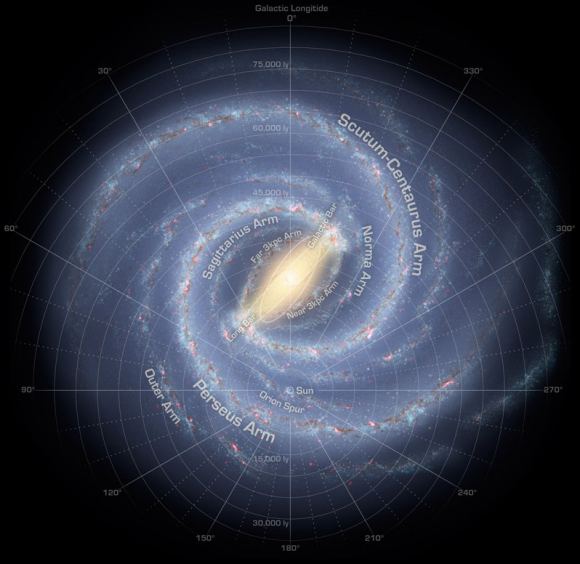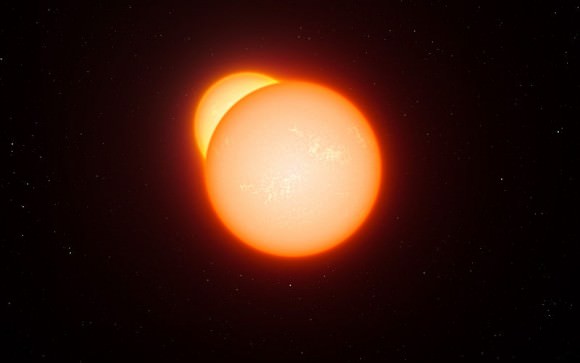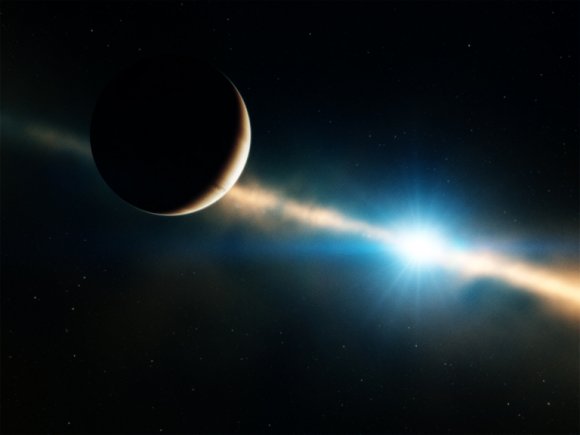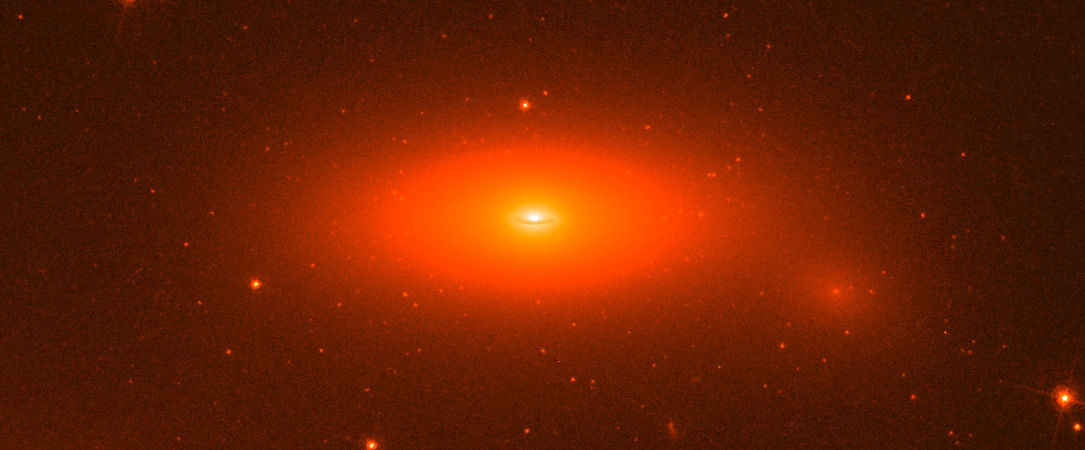An atlas doesn’t seem to be an essential item in cars these days but think about them and most people will think about distances. An atlas of the stars not only covers distances but must also take into account time too. The Andromeda galaxy for example is so far away that its light takes 2.5 million years to reach us. A team of researchers have now built a catalogue that contains information on millions of galaxies including their distance and looks back in time up to 10 billion years!
Continue reading “A New Catalog Charts the Evolution of the Universe Over Time”A Massive Galaxy With Almost No Dark Matter
According to our predominant cosmological models, Dark Matter accounts for roughly 85% of the mass in the Universe. While ongoing efforts to study this mysterious, invisible mass have yielded no direct evidence, astrophysicists have been able to measure its influence by observing Dark Matter Haloes, gravitational lenses, and the effect of General Relativity on large-scale cosmic structures. And with the help of next-generation missions like the ESA’s Euclid and NASA’s Nancy Grace Roman space telescopes, Dark Matter may not be a mystery for much longer!
And then something like this comes along: a massive galaxy that appears to have little or no Dark Matter! This is precisely what a team of astronomers led by members of the Instituto Astrofisica de Canarias (IAC) noticed when observing NGC 1277. This lenticular galaxy, located 240 million light-years away in the constellation Perseus, is several times more massive than the Milky Way. This is the first time a massive galaxy has been found that doesn’t show signs of Dark Matter, which is a serious challenge to our current cosmological models.
Continue reading “A Massive Galaxy With Almost No Dark Matter”Astronomers Find One of the Oldest Stars in the Milky Way
According to modern cosmological models, the Universe began in a cataclysm event known as the Big Bang. This took place roughly 13.8 billion years ago, and was followed by a period of expansion and cooling. During that time, the first hydrogen atoms formed as protons and electrons combined and the fundamental forces of physics were born. Then, about 100 million years after the Big Bang, that the first stars and galaxies began to form.
The formation of the first stars was also what allowed for the creation of heavier elements, and therefore the formation of planets and all life as we know it. However, until now, how and when this process took place has been largely theoretical since astronomers did not know where the oldest stars in our galaxy were to be found. But thanks to a new study by a team of Spanish astronomers, we may have just found the oldest star in the Milky Way!
The study, titled “J0815+4729: A chemically primitive dwarf star in the Galactic Halo observed with Gran Telescopio Canarias“, recently appeared in The Astrophysical Journal Letters. Led by David S. Aguado of the Instituto de Astrofisica de Canarias (IAC), the team included members from the University of La Laguna and the Spanish National Research Council (CSIC).

This star is located roughly 7,500 light years from the Sun, and was found in the halo of the Milky Way along the line of sight to the Lynx constellation. Known as J0815+4729, this star is still in its main sequence and has a low mass, (around 0.7 Solar Masses), though the research team estimates that it has a surface temperature that is about 400 degrees hotter – 6,215 K (5942 °C; 10,727 °F) compared to 5778 K (5505 °C; 9940 °F).
For the sake of their study, the team was looking for a star that showed signs of being metal-poor, which would indicate that it has been in its main sequence for a very long time. The team first selected J0815+4729 from the Sloan Digital Sky Survey-III Baryon Oscillation Spectroscopic Survey (SDSS-III/BOSS) and then conducted follow-up spectroscopic investigations to determine its composition (and hence its age).
This was done using the Intermediate dispersion Spectrograph and Imaging System (ISIS) at the William Herschel Telescope (WHT) and the Optical System for Imaging and low-intermediate-Resolution Integrated Spectroscopy (OSIRIS) at Gran Telescopio de Canarias (GTC), both of which are located at the Observatorio del Roque de los Muchachos on the island of La Palma.
Consistent with what modern theory predicts, the star was found in the Galactic halo – the extended component of our galaxy that reaches beyond the galactic disk (the visible portion). It is in this region that the oldest and most metal-poor stars are believed to be found in galaxies, hence why the team was confident that a star dating back to the early Universe would be found here.

As Jonay González Hernández – a professor from the University of La Laguna, a member of the IAC and a co-author on the paper – explained in an IAC press release:
“Theory predicts that these stars could use material from the first supernovae, whose progenitors were the first massive stars in the galaxy, around 300 million years after the Big Bang. In spite of its age, and its distance away from us, we can still observe it.”
Spectra obtained by both the ISIS and OSIRIS instruments confirmed that the star was poor in metals, indicating that J0815+4729 has only one-millionth of the calcium and iron that the Sun contains. In addition, the team also noticed that the star has a higher carbon content than our Sun, accounting for almost 15% percent of its solar abundance (i.e. the relative abundance of its elements).
In short, J0815+4729 may be the most iron-poor and carbon-rich star currently known to astronomers. Moreover, finding it was rather difficult since the star is both weak in luminosity and was buried within a massive amount of SDSS/BOSS archival data. As Carlos Allende Prieto, another IAC researcher and a co-author on the paper, indicated:
“This star was tucked away in the database of the BOSS project, among a million stellar spectra which we have analysed, requiring a considerable observational and computational effort. It requires high-resolution spectroscopy on large telescopes to detect the chemical elements in the star, which can help us to understand the first supernovae and their progenitors.”
In the near future, the team predicts that next-generation spectrographs could allow for further research that would reveal more about the star’s chemical abundances. Such instruments include the HORS high-resolution spectrograph, which is presently in a trial phase on the Gran Telescopio Canarias (GTC).
“Detecting lithium gives us crucial information related to Big Bang nucleosynthesis,” said Rafael Rebolo, the director of the IAC and a coauthor of the paper. “We are working on a spectrograph of high-resolution and wide spectral range in order to measure the detailed chemical composition of stars with unique properties such as J0815+4719.”
Further Reading: IAC, The Astrophysical Journal Letters
A Brown Dwarf Prevented a Regular Star from Going Through its Full Life Cycle

Eclipsing binary star systems are relatively common in our Universe. To the casual observer, these systems look like a single star, but are actually composed of two stars orbiting closely together. The study of these systems offers astronomers an opportunity to directly measure the fundamental properties (i.e. the masses and radii) of these systems respective stellar components.
Recently, a team of Brazilian astronomers observed a rare sight in the Milky Way – an eclipsing binary composed of a white dwarf and a low-mass brown dwarf. Even more unusual was the fact that the white dwarf’s life cycle appeared to have been prematurely cut short by its brown dwarf companion, which caused its early death by slowly siphoning off material and “starving” it to death.
The study which detailed their findings, titled “HS 2231+2441: an HW Vir system composed by a low-mass white dwarf and a brown dwarf“, was recently published the Monthly Notices of the Royal Astronomical Society. The team was led by Leonardo Andrade de Almeida, a postdoctoral fellow from the University of São Paolo’s Institute of Astronomy, Geophysics, and Atmospheric Sciences (IAG-USP), along with members from the National Institute for Space Research (MCTIC), and the State University of Feira de Santana.

For the sake of their study, the team conducted observations of a binary star system between 2005 and 2013 using the Pico dos Dias Observatory in Brazil. This data was then combined with information from the William Herschel Telescope, which is located in the Observatorio del Roque de los Muchachos on the island of La Palma. This system, known as of HS 2231+2441, consists of a white dwarf star and a brown dwarf companion.
White dwarfs, which are the final stage of intermediate or low-mass stars, are essentially what is left after a star has exhausted its hydrogen and helium fuel and blown off its outer layers. A brown dwarf, on the other hand, is a substellar object that has a mass which places it between that of a star and a planet. Finding a binary system consisting of both objects together in the same system is something astronomers don’t see everyday.
As Leonardo Andrade de Almeida explained in a FAPESP press release, “This type of low-mass binary is relatively rare. Only a few dozen have been observed to date.”
This particular binary pair consists of a white dwarf that is between twenty to thirty percent the Sun’s mass – 28,500 K (28,227 °C; 50,840 °F) – while the brown dwarf is roughly 34-36 times that of Jupiter. This makes HS 2231+2441 the least massive eclipsing binary system studied to date.

In the past, the primary (the white dwarf) was a normal star that evolved faster than its companion since it was more massive. Once it exhausted its hydrogen fuel, its formed a helium-burning core. At this point, the star was on its way to becoming a red giant, which is what happens when Sun-like stars exit their main sequence phase. This would have been characterized by a massive expansion, with its diameter exceeding 150 million km (93.2 million mi).
At this point, Almeida and his colleagues concluded that it began interacting gravitationally with its secondary (the brown dwarf). Meanwhile, the brown dwarf began to be attracted and engulfed by the primary’s atmosphere (i.e. its envelop), which caused it it lose orbital angular momentum. Eventually, the powerful force of attraction exceeded the gravitational force keeping the envelop anchored to its star.
Once this happened, the primary star’s outer layers began to be stripped away, exposing its helium core and sending massive amounts of matter to the brown dwarf. Because of this loss of mass, the remnant effectively died, becoming a white dwarf. The brown dwarf then began orbiting its white dwarf primary with a short orbital period of just three hours. As Almeida explained:
“This transfer of mass from the more massive star, the primary object, to its companion, which is the secondary object, was extremely violent and unstable, and it lasted a short time… The secondary object, which is now a brown dwarf, must also have acquired some matter when it shared its envelope with the primary object, but not enough to become a new star.”

This situation is similar to what astronomers noticed this past summer while studying the binary star system known as WD 1202-024. Here too, a brown dwarf companion was discovered orbiting a white dwarf primary. What’s more, the team responsible for the discovery indicated that the brown dwarf was likely pulled closer to the white dwarf once it entered its Red Giant Branch (RGB) phase.
At this point, the brown dwarf stripped the primary of its atmosphere, exposing the white dwarf remnant core. Similarly, the interaction of the primary with a brown dwarf companion caused premature stellar death. The fact that two such discoveries have happened within a short period of time is quite fortuitous. Considering the age of the Universe (which is roughly 13.8 billion years old), dead objects can only be formed in binary systems.
In the Milky Way alone, about 50% of low-mass stars exist as part of a binary system while high mass stars exist almost exclusively in binary pairs. In these cases, roughly three-quarters will interact in some way with a companion – exchanging mass, accelerating their rotations, and eventually en merging.
As Almeida indicated, the study of this binary system and those like it could seriously help astronomers understand how hot, compact objects like white dwarfs are formed. “Binary systems offer a direct way of measuring the main parameter of a star, which is its mass,” he said. “That’s why binary systems are crucial to our understanding of the life cycle of stars.”
It has only been in recent years that low-mass white dwarf stars were discovered. Finding binary systems where they coexist with brown dwarfs – essentially, failed stars – is another rarity. But with every new discovery, the opportunities to study the range of possibilities in our Universe increases.
Further Reading: São Paulo Research Foundation, MNRAS



